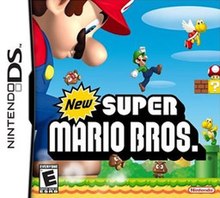| New Super Mario Bros. | |
|---|---|
 North American box art | |
| Developer(s) | Nintendo EAD |
| Publisher(s) | Nintendo |
| Director(s) | Shigeyuki Asuke |
| Producer(s) | Hiroyuki Kimura |
| Designer(s) | Masanao Arimoto |
| Programmer(s) |
|
| Composer(s) |
|
| Series | Super Mario |
| Platform(s) | Nintendo DS |
| Release | |
| Genre(s) | Platform |
| Mode(s) | Single-player, multiplayer |
New Super Mario Bros.[a] is a 2006 platform game developed and published by Nintendo for the Nintendo DS. It was first released in May 2006 in North America and Japan, and in PAL regions in June 2006. It is the first installment in the New Super Mario Bros. subseries of the Super Mario series and follows Mario as he fights his way through Bowser's henchmen to rescue Princess Peach. Mario has access to several old and new power-ups that help him complete his quest, including the Super Mushroom, the Fire Flower, and the Super Star, each giving him unique abilities. While traveling through eight worlds with more than 80 levels, Mario has to defeat Bowser Jr. and Bowser before saving Princess Peach.
New Super Mario Bros. released with critical and commercial success, with many considering it as the main contributor in the revival of the 2D platforming genre. Praise went towards the game's improvements and introductions made to the Mario franchise and faithfulness to older Mario games, while criticism was targeted at its low difficulty level and lingering similarities to previous games. It was called one of the best games available for the Nintendo DS by several critics with some further calling it one of the best side-scrolling Super Mario titles. It sold over 30 million copies worldwide, making it the best-selling game for the Nintendo DS and one of the best-selling video games of all time. The game's success led to a line of sequels, starting with New Super Mario Bros. Wii (2009).
Cite error: There are <ref group=lower-alpha> tags or {{efn}} templates on this page, but the references will not show without a {{reflist|group=lower-alpha}} template or {{notelist}} template (see the help page).